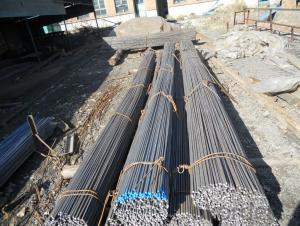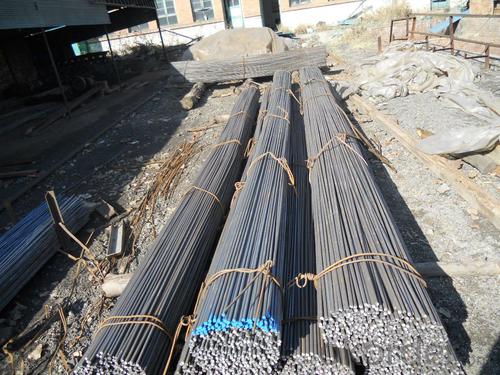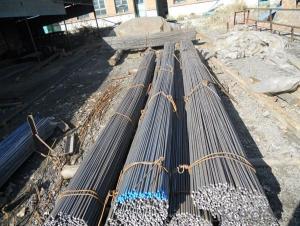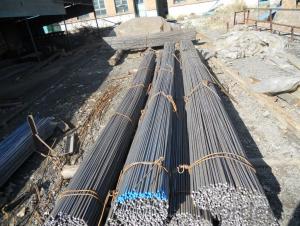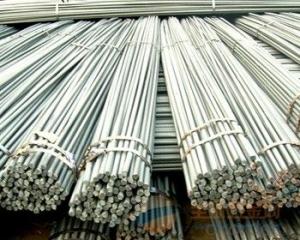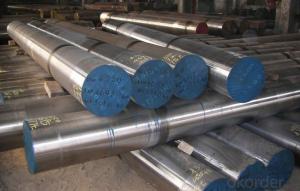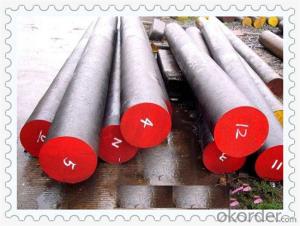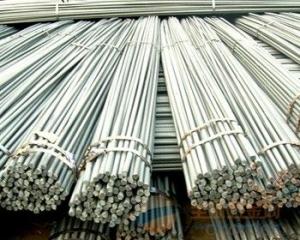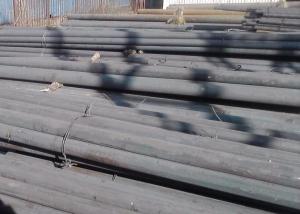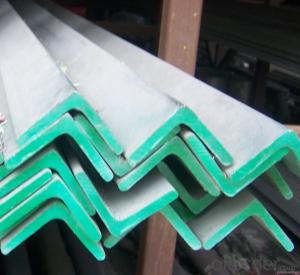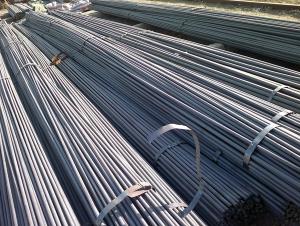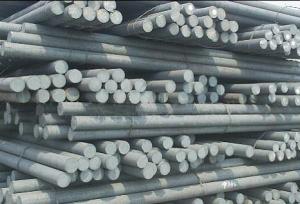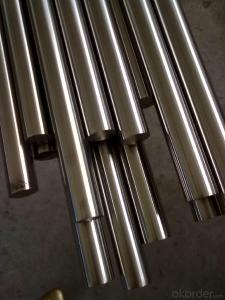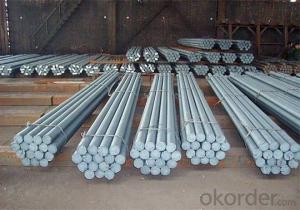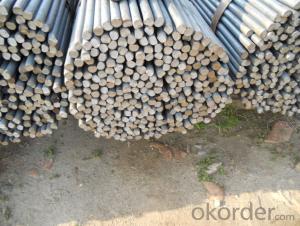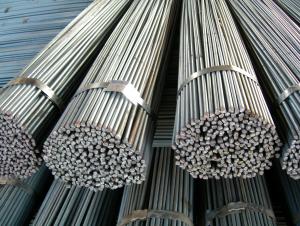round bars; round steel; high quality
- Loading Port:
- Tianjin
- Payment Terms:
- TT OR LC
- Min Order Qty:
- 1000 m.t.
- Supply Capability:
- 5000 m.t./month
OKorder Service Pledge
OKorder Financial Service
You Might Also Like
Product Description:
Specifications of Common Steel Round Bar
1. Grade: 304, 316L, 321
2. Type: Mild carbon steel
3. Shape: Round bar, solid bar of steel with circular section
4. Diameter: 8mm-150mm
5. HS Code: 72283010
Usage and Applications of Common Steel Round Bar
1. Common Steel Round Bar of 8-25mm, or small round is mostly used for straight bundles supply, and used for steel, bolts and various mechanical parts. While the bigger round bar, or more than 25mm hot rolled bar, is mainly for the manufacture of mechanical parts or for seamless steel billet.
2. Steel round bar is used in construction and a large number of architectural and engineering structures.
3. Besides, we can supply some especial material steel round bar that can be used for main shaft of steamer, hummer shank, with big section and supper force.
Packaging & Delivery of Common Steel Round Bar
Packaging Detail: All goods are packed in bundle with steel strips and shipped by break bulk vessel or container (depend on target market and different ports)
Delivery Detail: 45 days
Trade terms: FOB, CFR, CIF
MOQ: 25 tons per specification; we can negotiate the quantity if the specification is normal or we have stock of one specification.
Weight: The price invoicing on theoretical weight basis or actual weight basis depends on customer’s request.
Shipment: The shipment of bulk break or container is depends on customer’s request and the situation of the port of destination.
Documents given: Full set of original clean on board bill of lading; Original signed commercial invoice; Original packing list; Policy of insurance; Certificate of origin and what the target market needs.
Production Flow of Common Steel Round Bar
We use advanced equipments like Electric Arc Furnace, Ladle Furnace and Vacuum Degasser to produce our products.
Material prepare (billet) — heat up — rough rolling — precision rolling — cooling — packing — storage and transportation
- Q: What's the difference between pure iron round steel and electromagnetic pure iron bar?
- One thing, one thing, the same thing is round. However, in the general industry, about 30 of the habit is called bar,
- Q: Can steel round bars be used for making turbine blades?
- No, steel round bars cannot be used for making turbine blades. Turbine blades are subjected to high temperatures, extreme forces, and require high levels of durability and flexibility. Steel round bars do not possess the necessary properties to withstand these conditions. Turbine blades are typically made from materials such as titanium alloys or advanced composites that offer high strength-to-weight ratios, excellent fatigue resistance, and thermal stability. These materials are specifically engineered to withstand the demanding conditions of turbine operations, ensuring efficient and reliable performance.
- Q: Are steel round bars suitable for welding applications?
- Steel round bars are a great choice for welding. They are commonly used in welding applications because they are strong and durable. You can easily weld them to other steel components or structures using different welding processes like arc welding, MIG welding, or TIG welding. Steel round bars also have good mechanical properties, including excellent tensile strength. This makes them suitable for welding applications where strength and load-bearing capacity are important. They come in various sizes and grades, so you can use them for different welding projects. However, it's important to choose the right type of steel round bar for your specific welding application and desired final product properties.
- Q: What is the difference between a hot-rolled and a peeled steel round bar?
- A hot-rolled steel round bar is produced by heating a billet or ingot until it reaches a temperature where the material can be easily shaped or formed. Once heated, the steel is rolled through a series of rollers to achieve the desired shape and size. The process of hot rolling creates a bar with a rough surface texture and a slightly rounded edge. On the other hand, a peeled steel round bar undergoes a different manufacturing process. It is first hot-rolled to achieve the desired shape and size, similar to the hot-rolled bar. However, after the initial hot rolling, the peeled bar is subjected to a mechanical peeling process. This involves removing the outer layer of the bar to achieve a smooth, shiny surface finish. The peeling process also helps to improve the dimensional accuracy and surface quality of the bar. In summary, the main difference between a hot-rolled and a peeled steel round bar lies in the surface finish and dimensional accuracy. While a hot-rolled bar has a rough surface texture and a slightly rounded edge, a peeled bar has a smooth, shiny surface finish with improved dimensional accuracy. The peeling process enhances the overall quality and appearance of the steel round bar, making it more suitable for applications where aesthetics or precision is important.
- Q: Are steel round bars suitable for use in the construction of bridges?
- Yes, steel round bars are suitable for use in the construction of bridges. Steel round bars offer high tensile strength, durability, and flexibility, making them ideal for withstanding heavy loads and structural demands. They also provide excellent resistance to corrosion, ensuring longevity and structural integrity. Additionally, steel round bars can be easily fabricated and installed, making them a cost-effective choice for bridge construction projects.
- Q: What are the advantages of using nickel-tungsten alloy steel round bars?
- There are several advantages to using nickel-tungsten alloy steel round bars. Firstly, the inclusion of nickel enhances the corrosion resistance of the bars, making them suitable for use in harsh environments. Additionally, the addition of tungsten improves the strength and hardness of the bars, making them highly durable and able to withstand heavy loads and high temperatures. Furthermore, the alloy steel composition provides excellent wear resistance, making these bars ideal for applications that require prolonged use or frequent contact with abrasive materials. Overall, nickel-tungsten alloy steel round bars offer a combination of corrosion resistance, strength, and durability, making them a reliable choice for various industrial applications.
- Q: Can steel round bars be used for making handrails?
- Yes, steel round bars can be used for making handrails. Steel round bars are commonly used in construction and fabrication due to their strength and durability. They can be easily shaped and welded to create handrails that provide support and safety for staircases, balconies, and other elevated areas. Additionally, steel round bars can be finished with various coatings or treatments to enhance their corrosion resistance and aesthetics. Overall, steel round bars are a popular choice for making handrails due to their strength, versatility, and ability to withstand heavy usage.
- Q: What is the difference between carbon steel and alloy steel round bars?
- Carbon steel and alloy steel round bars are both widely used in various industries, but they differ in their composition and properties. Carbon steel round bars are primarily made up of iron and carbon, with trace amounts of other elements. The carbon content typically ranges from 0.05% to 2.0%, depending on the grade. These bars are known for their strength and hardness, making them suitable for applications that require high durability and wear resistance. Carbon steel round bars also have good machinability, meaning they can be easily shaped and formed into desired configurations. However, they may have limited corrosion resistance and may require additional protective coatings in corrosive environments. On the other hand, alloy steel round bars are made by adding various alloying elements to carbon steel. These alloying elements can include elements such as manganese, chromium, nickel, and molybdenum, among others. The addition of these elements enhances the properties of the steel, such as increased strength, toughness, and resistance to wear and corrosion. Alloy steel round bars are often chosen for applications that require specific properties, such as high temperature resistance, high strength-to-weight ratio, or improved machinability. In summary, the main difference between carbon steel and alloy steel round bars lies in their composition and resulting properties. Carbon steel round bars are primarily made up of iron and carbon, offering good strength and hardness, but may have limited corrosion resistance. Alloy steel round bars, on the other hand, have added alloying elements that enhance specific properties, such as increased strength, toughness, and corrosion resistance. The choice between carbon steel and alloy steel round bars will depend on the specific requirements of the application.
- Q: What is the difference between a cold-drawn and a polished steel round bar?
- A cold-drawn steel round bar and a polished steel round bar differ in their manufacturing processes and resulting properties. A cold-drawn steel round bar is produced by pulling or drawing a hot-rolled steel bar through a die or series of dies to reduce its diameter and increase its length. This process is done at room temperature, which imparts certain characteristics to the steel. Cold-drawn steel bars have a smooth and shiny surface, with tight dimensional tolerances and improved mechanical properties. The cold drawing process refines the microstructure of the steel, making it stronger, more uniform, and less prone to defects. These bars are commonly used in applications that require high strength, precision, and resistance to fatigue, such as automotive components, machinery, and tooling. On the other hand, a polished steel round bar undergoes a different treatment process. After the steel bar is formed, it goes through polishing, which involves grinding or buffing the surface to achieve a smooth and reflective finish. Polished steel bars have a shiny and mirror-like appearance due to the removal of surface imperfections and contaminants. This process is primarily done for aesthetic purposes and does not significantly alter the mechanical properties of the steel. Polished steel round bars are commonly used in decorative applications, architectural designs, and furniture. In summary, the main difference between a cold-drawn and a polished steel round bar lies in their manufacturing processes and intended applications. Cold-drawn bars undergo a precise cold drawing process to improve their mechanical properties, while polished bars are subjected to surface polishing for an aesthetically pleasing finish.
- Q: What are the different types of steel round bar finishes?
- There are several different types of steel round bar finishes available, each with its own unique properties and benefits. Some common types of steel round bar finishes include: 1. Hot Rolled: This finish is achieved by heating the steel to a high temperature and then rolling it while it is still hot. Hot rolled steel round bars have a rough surface and a blue-grey color. This finish is commonly used for structural applications where aesthetics are not a priority. 2. Cold Rolled: In contrast to hot rolled steel, cold rolled steel round bars are processed at room temperature. This results in a smoother surface and tighter dimensional tolerances. Cold rolled steel round bars are often used in applications that require a more polished look or where precise measurements are essential. 3. Turned and Polished: This finish involves removing the outer layer of the steel round bar through a process called turning. After turning, the bar is polished to achieve a smooth and shiny surface. Turned and polished steel round bars are commonly used in decorative applications or where a high-quality appearance is desired. 4. Ground: Ground steel round bars undergo a grinding process to remove imperfections and achieve a smooth, uniform surface. This finish is often used when tight tolerances and precise measurements are required, such as in machine parts or tools. 5. Chrome Plated: Chrome plating involves applying a layer of chromium onto the surface of the steel round bar. This finish provides enhanced corrosion resistance and a lustrous appearance. Chrome plated steel round bars are frequently used in applications where the material will be exposed to moisture or harsh environments. 6. Galvanized: Galvanizing is the process of coating steel with a layer of zinc to protect it from corrosion. Galvanized steel round bars have a characteristic silver appearance and are commonly used in outdoor applications or environments where rust is a concern. These are just a few examples of the different types of steel round bar finishes available. The choice of finish will depend on the specific requirements of the application, such as aesthetics, corrosion resistance, or dimensional tolerances.
Send your message to us
round bars; round steel; high quality
- Loading Port:
- Tianjin
- Payment Terms:
- TT OR LC
- Min Order Qty:
- 1000 m.t.
- Supply Capability:
- 5000 m.t./month
OKorder Service Pledge
OKorder Financial Service
Similar products
Hot products
Hot Searches
Related keywords
